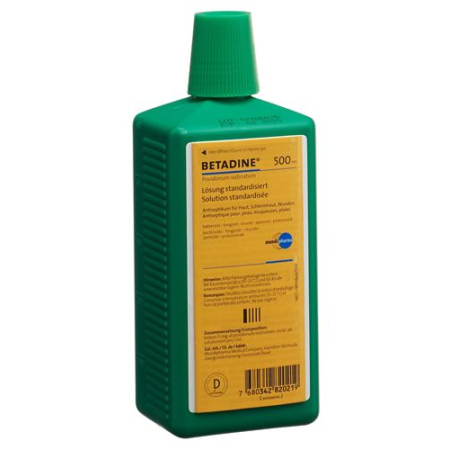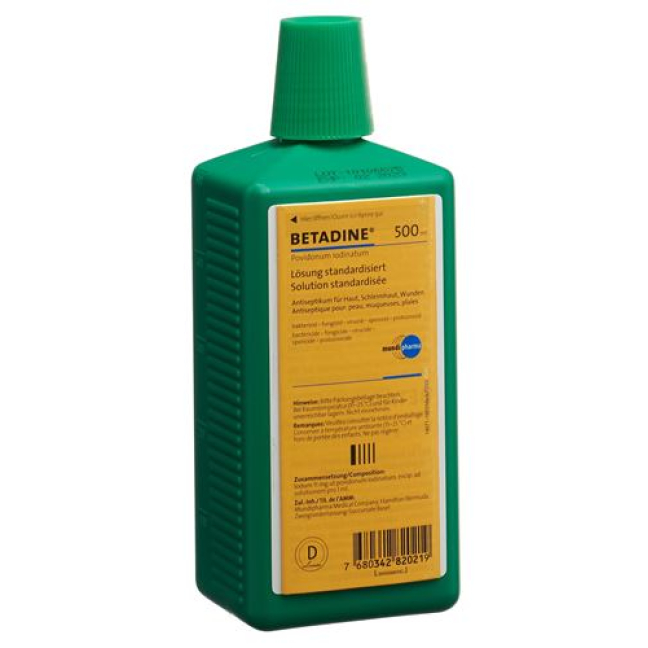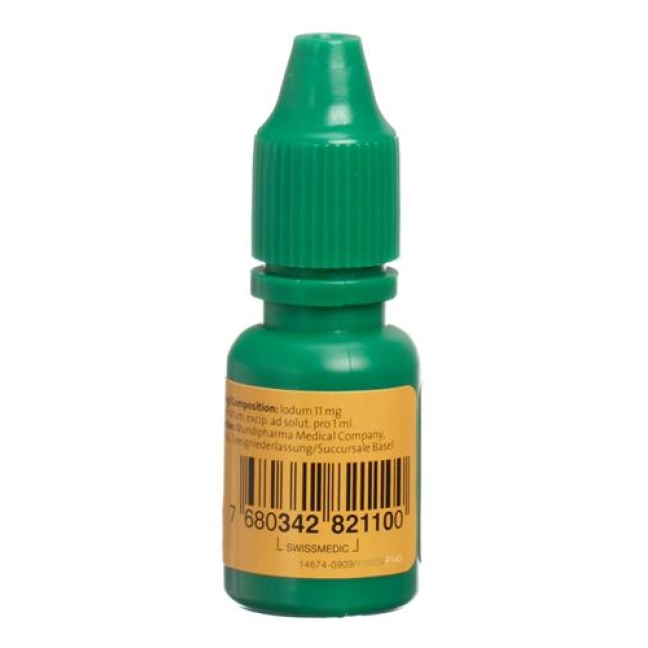Betadine solution standardized Lös Fl 500 ml
-
30.24 USD

- Availability: In stock
- Brand: MUNDIPHARMA MEDICAL
- Product Code: 780239
- ATC-code D08AG02
- EAN 7680342820219
Description
What is Betadine Solution standardized and when is it used?
Betadine Solution standardized is a disinfectant for external use. It kills bacteria, fungi, viruses and other pathogens that cause infection.
Betadine Solution standardized is used to disinfect the skin and mucous membranes as well as to disinfect minor wounds, skin tears, abrasions and small, minor burns (burns without blistering).
Betadine Solution is used in a standardized way to treat infected wounds only if prescribed by a doctor.
What precautions should be taken?
Large, heavily soiled and deep wounds as well as severe burns, bites and puncture wounds require medical treatment (including the risk of tetanus). If the size of a wound remains unchanged for some time or if the wound does not heal within 10-14 days, a doctor's visit is also necessary; The same applies if the edges of the wound are very red, the wound suddenly swells, is very painful or the injury is accompanied by fever (danger of blood poisoning).
When should Betadine Solution standardized not be used?
Betadine Solution standardized must not be used:
- if you are hypersensitive to povidone-iodine, iodine or any other ingredient,
- for dysfunction and diseases of the thyroid gland,
- in dermatitis herpetiformis Duhring (very rare, herpes-like skin disease),
- before, during and until the end of an examination or treatment of the thyroid with labeled iodine (radio-iodine application), as this is impaired by Betadine solution in a standardized way,
- with the simultaneous use of preparations containing mercury, since a substance is formed that can damage the skin,
- in children under 1 year.
When is standardized caution required when using Betadine Solution?
If you suffer from thyroid disease or you have a goiter, you should only use Betadine solution if you have been told to do so by your doctor. Even after the end of treatment, early symptoms of possible hyperthyroidism should be observed for up to 3 months. Your doctor may monitor your thyroid function.
Betadine Solution standardized should not be used during pregnancy and breastfeeding because thyroid dysfunction can occur in the unborn child and infants (see «Can Betadine solution standardized be used during pregnancy or while breastfeeding?»).
Betadine Solution standardized may only be used in small children aged 1-6 years if prescribed by a doctor. Thyroid function may need to be checked. Any ingestion of Betadine solution standardized by a child should be avoided at all costs
When skin is disinfected before an operation, an accumulation of standardized Betadine solution in skin folds or under the patient should be avoided, as prolonged skin contact with the undried solution can cause skin irritation and, in rare cases, severe skin reactions similar to burns.
Do not heat before use.
Betadine Solution standardized must not penetrate under electrode pads.
In the case of metabolic acidosis of the blood (metabolic acidosis) and kidney failure, standardized Betadine solution should not be used or the treatment should be discontinued.
Betadine Solution standardized must not be swallowed when used in the mouth and throat area, as otherwise breathing difficulties up to pneumonia can occur.
Betadine Solution standardized must not be used at the same time as or shortly after enzymatic wound treatment agents or disinfectants containing silver sulfadiazine, hydrogen peroxide or taurolidine, as this can lead to a mutual weakening of the effect.
Do not use Betadine Solution standardized at the same time as or immediately after use of disinfectants containing octenidine on the same or adjacent areas, as this may result in temporary dark discoloration.
If you are being treated with lithium preparations, you should avoid using Betadine solution standardized for a longer period of time or over a large area, since absorbed iodine can promote the possible triggering of hypothyroidism by lithium.
Tell your doctor, pharmacist or druggist if you
- suffer from other diseases
- have allergies or
- take other medicines (including those you bought yourself!) or use them externally!
Can Betadine Solution be used standardized during pregnancy or while breastfeeding?
Betadine solution standardized should not be used during pregnancy and lactation because the unborn child or newborn is exposed to relevant amounts of iodine via the mother and serious thyroid dysfunction can occur in the newborn.
Accidental ingestion of Betadine solution standardized by the infant through the mouth through contact with the treated part of the nursing mother's body must be avoided. Tell your doctor, pharmacist or druggist if you are pregnant or breastfeeding.
How do you use Betadine Solution standardized?
Adults, teenagers and children from 6 years
Unless otherwise instructed by your doctor, apply Betadine solution as follows:
Minor injuries and skin damage, minor burns
Undiluted directly from the bottle, drip evenly onto the area to be treated or apply carefully and thickly with a soaked gauze. Leave to act for 2-3 minutes or allow to dry. If the applied Betadine solution discolours in a standardized manner, repeat the treatment.
Immersion baths
Add the standardized Betadine solution to the bath water at body temperature until the color corresponds to that of a strong black tea (recommended dilutions: antiseptic partial baths approx. 1:25, antiseptic full baths approx. 1:100). Bathe the part of the body to be treated (fingers, feet, arms, etc.) in this solution for about 10 minutes.
Children from 1 to 6 years
Betadine solution standardized must not be used in newborns and infants under the age of 1 year (see “When must Betadine solution standardized not be used?”). Use in small children up to 6 years of age only if prescribed by a doctor (see “When is caution required when using Betadine solution standardized?”).
Special dosage instructions
Unless otherwise prescribed by your doctor, standardized Betadine solution is used 1-3 times a day as required. As long as the golden-brown color of the standardized Betadine solution is visible, the solution coating has a disinfecting effect. Discoloration means a decrease in effectiveness and signals that a new application should take place. Therefore, apply new standardized Betadine solution if you notice a clear discoloration. Continue treatment until healing.
If your symptoms have not improved after several days (2-5 days) of regular use, or if symptoms recur after the treatment is complete, you should see your doctor.
In the event of accidental ingestion, the doctor must be informed immediately.
Follow the dosage given in the package leaflet or prescribed by your doctor. If you think the medicine is too weak or too strong, talk to your doctor, pharmacist or druggist.
What side effects can Betadine solution standardized have?
Rare (affects 1 to 10 users in 10,000)
In rare cases, hypersensitivity or contact dermatitis (with symptoms such as skin redness, blisters or itching) may occur.
When skin is disinfected before operations, the accumulation of standardized Betadine solution in skin folds or under the patient can lead to skin burns.
Very rare (affects less than 1 in 10,000 people)
In very rare cases, acute and painful swelling of the skin or mucous membranes (angioedema) and acute general allergic reactions, possibly with a drop in blood pressure and/or shortness of breath (anaphylactic reaction), can occur. In such cases, treatment with standardized Betadine solution must be stopped immediately and the doctor informed immediately.
Significant iodine uptake may occur with prolonged use on extensive areas of skin, wounds, or burns. In very rare cases, patients with thyroid disorders may experience hyperthyroidism with symptoms such as increased heart rate or inner restlessness.
In individual cases, hypothyroidism, disturbances in the electrolyte balance, metabolism-related hyperacidity of the blood (metabolic acidosis), acute kidney failure and abnormal blood osmolarity can occur.
Pneumonia may occur as a result of ingestion after application to the mouth and throat.
If you notice side effects, contact your doctor, pharmacist or druggist. This also applies in particular to side effects that are not listed in this leaflet.
What should also be noted?
Durability
The medicinal product may only be used up to the date marked “EXP” on the container.
Use-by period after opening
The medicinal product can be kept for 3 years after opening if tightly closed.
Storage Notice
Store at room temperature (15-25°C) and out of the reach of children.
More information
Don't ingest.
Betadine solution standardized - stains can be washed out of natural fibers with soap and water, of synthetic fibers with diluted ammonia or sodium thiosulphate solution.
Iodine vapors can discolour plastics, coverings, paintwork, etc. For this reason, close the containers well with standardized Betadine solution. If a yellowish precipitate appears, immediate cleaning is recommended. When used as a bath, good ventilation is important, especially in small and closed rooms.
Your doctor, pharmacist or druggist can provide you with further information. These people have the detailed information for specialists.
What is standardized in Betadine solution?
1 ml solution contains 11 mg iodine as povidone iodine and excipients
Registration Number
34282 (Swissmedic)
Where can you get standardized Betadine solution? What packs are available?
In pharmacies and drugstores, without medical prescription.
Bottles of 10, 30, 60, 120 and 500 ml.
Pocket pharmacy with bottle of 10 ml.
Marketing Authorization Holder
Mundipharma Medical Company, Hamilton/Bermuda, Basel branch





